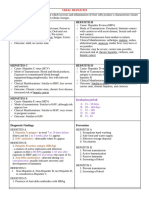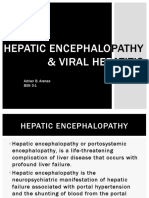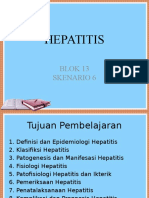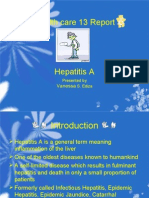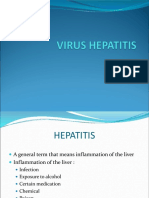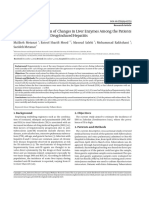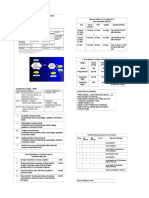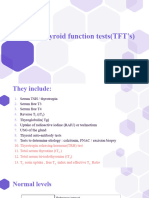Sas S9
Sas S9
Uploaded by
Ralph Louie ManagoCopyright:
Available Formats
Sas S9
Sas S9
Uploaded by
Ralph Louie ManagoOriginal Title
Copyright
Available Formats
Share this document
Did you find this document useful?
Is this content inappropriate?
Copyright:
Available Formats
Sas S9
Sas S9
Uploaded by
Ralph Louie ManagoCopyright:
Available Formats
CARE OF CLIENTS WITH PROBLEM IN
NUTRITION, AND GASTRO-INTESTINAL,
METABOLISM AND ENDOCRINE,
PERCEPTION AND COORDINATION, (ACUTE
STUDENT’S ACTIVITY SHEET AND CHRONIC)
BS NURSING / THIRD YEAR
Session # 9 (2 hours and 30 minutes)
Materials:
LESSON TITLE: VIRAL HEPATITIS, NONVIRAL HEPATITIS, Book, pen and notebook, projector
AND HEPATIC CIRRHOSIS
LEARNING OUTCOMES: References:
Upon completion of this lesson, the nursing student can:
Smeltzer, S., Bare, B., Hinkle, J., & Cheever, K.
1. identify the risk factors of the different types of hepatitis.
(2008). Brunner &Suddarth’s Textbook of
2. point out preventive measures on hepatitis.
Medical-Surgical Nursing 12th Edition.
3. determine the different clinical manifestations on hepatic
Lippincott Williams &Wilkins
cirrhosis.
4. recognize medical and nursing management of the disorders.
LESSON REVIEW / PREVIEW OR HOOK ACTIVITY (5 minutes)
The instructor will ask the students to answer the following.
1. Compare the various types of hepatitis: their causes, mode of transmission, and clinical manifestations.
MAIN LESSON (2 hours)
The students will study and read their book about this lesson (Chapter 39 of the book).
VIRAL HEPATITIS
Viral hepatitis is a systemic, viral infection in which necrosis and inflammation of liver cells produce a
characteristic cluster of clinical, biochemical, and cellular changes.
HEPATITIS A
Cause: Hepatitis A virus (HAV)
Mode of Transmission: Fecal-oral route; Person to person; Water-borne; Food-borne; Oral-anal sex
Incubation: 15 – 50 days
Clinical Manifestations: Flu-like; Preicteric: anorexia, headache, fever, malaise, fatigue; Icteric: Jaundice, dark urine,
tender liver
Outcome: mild; no carrier state
HEPATITI B
Cause: Hepatitis B virus (HBV)
Mode of Transmission: Parenteral; Intimate contact with carriers or with acute disease; Sexual and oral-oral contact;
Perinatal transmission from mother to infants
Incubation: 28 – 160 days
Clinical Manifestations: arthralgia, malaise, rashes, abdominal pain, anorexia, tender liver; may have or no jaundice
Outcome: may be severe; carrier state possible; increased risk of chronic hepatitis, cirrhosis, and hepatic cancer
HEPATITIS C
Cause: Hepatitis C virus (HCV)
Mode of Transmission: Blood and blood products; Exposure to contaminated blood through equipment/drug
paraphernalia; Sex with infected partner
Incubation: 15 – 160 days
This document and the information thereon is the property of PHINMA
Education (Department of Nursing) 1 of 9
Clinical Manifestations: Similar to HBV; less severe and anicteric
Outcome: Chronic carrier state; chronic liver disease; increased risk of hepatic cancer
HEPATITIS D
Cause: Hepatitis D virus (HDV)
Mode of Transmission: Same as HBV; HBV surface antigen is necessary for replication; pattern similar to hepatitis B
Incubation: 21 – 140 days
Clinical Manifestations: Similar to HBV
Outcome: Similar to HBV; but greater likelihood of carrier state, chronic hepatitis, and cirrhosis
HEPATITIS E
Cause: Hepatitis E virus (HEV)
Mode of transmission: Similar to HAV; although risk appears low
Incubation: 15 – 65 days
Clinical Manifestations: Similar to HAV; very severe in pregnant women
Outcome: Similar to HAV
Diagnostic Findings
HEPATITIS A
1. Hepatitis A antigen – in stool 7 to 10 days before illness and for 2 to 3 weeks after symptoms appear
2. HAV antibodies – are detectable when symptoms appear
HEPATITIS B
1. Hepatitis B surface antigen (HBsAg) – a marker of active replication and infection
- appears in the blood in 80-90% of infected patients 1 to 10 weeks after exposure to HBV and 2 to 8
weeks before the onset of symptoms
2. Anti-HBs (antibodies) – detected during late convalescence; usually indicates recovery and development of
immunity
HEPATITIS C
1. Non-Hepatitis A, Non-Hepatitis B, nor Hepatitis D, is considered as Hepatitis C
HEPATITIS D
1. Presence of Anti delta antibodies with HBAg
Prevention
HEPATITIS A HEPATITIS B HEPATITIS C
1. Scrupulous hand washing 1. Prevent transmission 1. Prevent transmission
2. Safe food and water supply 2. Active Immunization 2. Screening of blood
3. Effective sewage disposal 3. Passive Immunity
4. Vaccination 4. Screening of blood
Medical Management
1. Bed rest during acute stage
2. Nutritious foods
During anorexia period: small frequent feedings supplemented by IV fluids with glucose
3. Avoid alcohol and medications /herbs that may affect liver function
4. Pharmacologic:
HEPATITIS B: Alpha-interferon for 4 to 6 months
Lamivudine (Epivir) and Adefovir (Hepsera) – have improved seroconversion rates, loss of
detectable virus, improved liver function, and reduced progression to cirrhosis with
Lamivudine. Adefovir may be effective in people resistant to Lamivudine.
HEPATITIS C: Combination of two: Interferon (Intron-A) and Ribavirin (Rebetol)
NONVIRAL HEPATITIS
This document and the information thereon is the property of PHINMA
Education (Department of Nursing) 2 of 9
Certain chemicals have toxic effects on the liver and produce acute liver cell necrosis or toxic hepatitis
when inhaled, injected parenterally, or are taken by mouth. The chemicals most commonly implicated in this disease
are carbon tetrachloride, phosphorus, chloroform, and gold compounds. These substances are true hepatotoxins.
Drug-induced hepatitis is similar to acute viral hepatitis, but parenchymal destruction tends to be more extensive.
Medications that can lead to hepatitis include Isoniazid (Nydrazid), Halothane (Fluothane), Acetaminophen,
Methyldopa (Aldomet), and certain Antibiotics, Antimetabolites, and Anesthetic agents.
TOXIC HEPATITIS
Clinical manifestations
1. Anorexia, nausea, and vomiting - usual symptoms
2. Jaundice and hepatomegaly - noted on physical assessment.
3. Severe cases:
a. Fever rise
b. Persistent vomiting with the emesis containing blood
c. Severe clotting abnormalities and hemorrhages
d. Severe GI symptoms that may lead to vascular collapse
e. Delirium, coma, and seizures may develop
f. Death due to fulminant hepatic failure
Medical management
1. Early identification and removal of the hepatotoxin
2. Maintain fluid and electrolyte balance
3. Blood replacement
4. Liver transplant
DRUG-INDUCED HEPATITIS
Drug-induced liver disease is the most common cause of acute liver failure. Use of acetaminophen (found
in many over-the-counter medications used to treat fever and pain) has been identified as the leading cause of
acute liver failure.
Clinical manifestations
1. Onset is abrupt, with chills, fever, rash, pruritus, arthralgia, anorexia, and nausea
2. Later: jaundice, dark urine, and an enlarged and tender liver
If fever, rash, or pruritus occurs from any medication, its use should be stopped immediately.
Medical management
1. Removal of the offending medication
2. Short course of high-dose corticosteroids
3. Liver transplantation
HEPATIC CIRRHOSIS
Cirrhosis is a chronic disease characterized by replacement of normal liver tissue with diffuse fibrosis (scar
formation) that disrupts the structure and function of the liver.
Types
1. Alcoholic cirrhosis: the most common type
2. Post necrotic cirrhosis: results from a late result of a previous bout of acute viral hepatitis.
3. Biliary cirrhosis: around the bile duct that results from chronic biliary obstruction and infection (cholangitis); much
less common type.
Pathophysiology
1. Alcohol consumption is considered the major causative factor.
2. Excessive alcohol intake is the major causative factor in fatty liver and its consequences.
3. Exposure to certain chemicals (carbon tetrachloride, chlorinated naphthalene, arsenic, or phosphorus) or
infectious schistosomiasis.
4. Twice as many men as women are affected.
This document and the information thereon is the property of PHINMA
Education (Department of Nursing) 3 of 9
5. Most patients are between 40 and 60 years of age.
Clinical Manifestations
Signs and symptoms of cirrhosis increase in severity as the disease progresses. Their severity is used to
categorize the disorder as compensated or decompensated cirrhosis.
1. Early:
a. Liver enlargement (hepatomegaly)
b. Abdominal pain
c. Intermittent jaundice and fever
d. Anorexia
e. Vomiting
2. Late:
a. Liver decreases in size as scar tissue contracts the liver tissue
b. Portal Obstruction and Ascites
c. Infection and Peritonitis
d. Gastrointestinal Varices
e. Edema (often affects the lower extremities, the upper extremities, and the presacral area)
f. Vitamin Deficiency and Anemia
g. Mental Deterioration
Compensated:
a. Intermittent mild fever
b. Vascular spiders
c. Palmar erythema (reddened palms)
d. Unexplained epistaxis
e. Ankle edema
f. Vague morning indigestion
g. Flatulent dyspepsia
h. Abdominal pain
i. Firm, enlarged liver
j. Splenomegaly
Decompensated:
a. Ascites
b. Jaundice
c. Weakness
d. Muscle wasting
e. Weight loss
f. Continuous mild fever
g. Clubbing of fingers
h. Purpura (due to decreased platelet count)
i. Spontaneous bruising
j. Epistaxis
k. Hypotension
l. Sparse body hair
m. White nails
n. Gonadal atrophy
Assessment and Diagnostic Findings
1. Increased levels: serum enzymes alkaline phosphatase, AST, ALT, and GGT; bilirubin; globulin
2. Decreased levels: serum albumin; cholinesterase
3. Prolonged Prothrombin time
4. Ultrasound scanning is used to measure the difference in density of parenchymal cells and scar tissue
5. CT, MRI, and radioisotope liver scans give information about liver size and hepatic blood flow and obstruction
6. Liver biopsy – confirms the diagnosis
Nursing Diagnoses
This document and the information thereon is the property of PHINMA
Education (Department of Nursing) 4 of 9
1. Activity intolerance related to fatigue, muscle wasting
2. Imbalanced nutrition: Less than body requirements related to chronic gastritis, decreased GI motility, anorexia
3. Impaired skin integrity related to edema, jaundice, poor nutrition
4. Risk to injury and bleeding related to altered clotting mechanisms, muscle wasting
5. Ineffective breathing pattern related to ascites, fluid in the thoracic cavity
6. Fluid volume excess related to sodium and water retention
Medical Management
1. Antacids or histamine-2 (H2) antagonists - decrease gastric distress and minimize the possibility of GI bleeding
2. Vitamins and nutritional supplements - promote healing of damaged liver cells and improve the patient’s general
nutritional status
3. Potassium-sparing diuretics such as Spironolactone or Triamterene (Dyrenium) - decreases ascites
4. Adequate diet and avoidance of alcohol.
5. Colchicine, an anti- inflammatory agent - may increase survival time in patients with mild to moderate cirrhosis
6. Medications such as Angiotensin system inhibitors, Statins, Diuretics, Immunosuppressants, and Glitazones -
possess antifibrotic activity for the treatment of cirrhosis.
7. Albumin infusion
8. Herb milk thistle (Silybum marianum) - treats jaundice and other symptoms because of its healing and
regenerative properties for liver disease. Silymarin from milk thistle has anti-inflammatory and antioxidant
properties that may have beneficial effects, especially in hepatitis.
9. Oxygen therapy may be required in liver failure - oxygenates damaged cells and prevents further cell
destruction.
10. Paracentesis
Nursing Management
A. Promote Rest
1. To permit the liver to reestablish its functional ability; reduces the demands on the liver and increases the
liver’s blood supply
2. If the patient is hospitalized: measure and record weight and fluid intake and output daily
3. Adjust the patient’s position in bed for maximal respiratory efficiency, which is especially important if ascites
is marked, because it interferes with adequate thoracic excursion
4. After nutritional status improves and strength increases: encourage the patient to increase activity gradually
B. Improve Nutritional Status
1. Nutritious, high-protein diet, if tolerated, supplemented by vitamins of the B complex, as well as A, C, and
K
2. If ascites is present: small, frequent meals
3. Patients with prolonged or severe anorexia and those who are vomiting or eating poorly: enteral or
parenteral feeding
4. Patients with fatty stools (steatorrhea): water-soluble forms of fat-soluble vitamins A, D, and E (Aquasol A,
D, and E)
5. Folic acid and iron to prevent anemia
6. If with signs of impending or advancing coma: protein in the diet is decreased temporarily (protein is
restricted if encephalopathy develops; incorporating vegetable protein to meet protein needs may decrease
the risk for encephalopathy)
7. Restrict sodium to prevent ascites.
C. Provide Skin Care
Providing careful skin care is important because of subcutaneous edema, the patient’s immobility,
jaundice, and in- creased susceptibility to skin breakdown and infection.
1. Frequent changes in position to prevent pressure ulcers
2. Avoid irritating soaps and the use of adhesive tape to prevent trauma to the skin
3. Apply lotion and minimize scratching to irritated skin
D. Reduce Risk of Injury
1. Side rails should be in place and padded with blankets or other materials in case the patient becomes
agitated or restless
2. Orient the patient to time and place and explains all procedures to minimize agitation
3. Assist patient in getting out of bed
4. Use electric razor rather than a safety razor; soft-bristled toothbrush; apply pressure to all venipuncture
sites; and maintain a sharp-free environment
This document and the information thereon is the property of PHINMA
Education (Department of Nursing) 5 of 9
E. Monitor and Manage Potential Complications:
1. Bleeding and Hemorrhage
2. Hepatic Encephalopathy
- Monitor mental and neurologic status
3. Fluid Volume Excess
- Observe for signs of ascites: fluid retention: lower extremity swelling, and dyspnea
- Monitor intake and output, daily weight changes, changes in abdominal girth, and edema
- Monitor for nocturia and, later, for oliguria
CHECK FOR UNDERSTANDING (20 minutes)
The instructor will prepare 10-15 questions that can enhance critical thinking skills. Students will work by themselves to
answer these questions and write the rationale for each question.
Multiple Choice
(For 1-15 items, please refer to the questions in the Rationalization Activity)
RATIONALIZATION ACTIVITY (DURING THE FACE TO FACE INTERACTION WITH THE STUDENTS)
The instructor will now rationalize the answers to the students and will encourage them to ask questions and to discuss
among their classmates for 20 minutes.
1. When planning home care for a client with hepatitis A, which preventive measure should be emphasized to protect the
client’s family?
A. Keeping the client in complete isolation.
B. Using good sanitation with dishes and shared bathrooms.
C. Avoiding contact with blood-soiled clothing or dressing.
D. Forbidding the sharing of needles or syringes.
Answer: _____
Rationale:________________________________________________________________________________________
_________________________________________________________________________________________________
_________________________________________________________________________________________________
2. Which of the following will the nurse include in the care plan for a client hospitalized with viral hepatitis?
A. Increase fluid intake to 3000 ml per day
B. Adequate bed rest
C. Bland diet
D. Administer antibiotics as ordered
Answer: _____
Rationale:________________________________________________________________________________________
_________________________________________________________________________________________________
_________________________________________________________________________________________________
3. Nathaniel has severe pruritus due to having hepatitis B. What is the best intervention for his comfort?
A. Give tepid baths.
B. Avoid lotions and creams.
C. Use hot water to increase vasodilation.
D. Use cold water to decrease the itching.
Answer: _____
Rationale:________________________________________________________________________________________
_________________________________________________________________________________________________
_________________________________________________________________________________________________
4. You’re discharging Nathaniel with hepatitis B. Which statement suggests understanding by the patient?
A. “Now I can never get hepatitis again.”
B. “I can safely give blood after 3 months.”
C. “I’ll never have a problem with my liver again, even if I drink alcohol.”
This document and the information thereon is the property of PHINMA
Education (Department of Nursing) 6 of 9
D. “My family knows that if I get tired and start vomiting, I may be getting sick again.”
Answer: _____
Rationale:________________________________________________________________________________________
_________________________________________________________________________________________________
_________________________________________________________________________________________________
5. A client is suspected of having hepatitis. Which diagnostic test result will assist in confirming this diagnosis?
A. Elevated hemoglobin level
B. Elevated serum bilirubin level
C. Elevated blood urea nitrogen level
D. Decreased erythrocyte sedimentation rate
Answer: _____
Rationale:________________________________________________________________________________________
_________________________________________________________________________________________________
_________________________________________________________________________________________________
6. A female client who has just been diagnosed with hepatitis A asks, “How could I have gotten this disease?” What is the
nurse’s best response?
A. “You may have eaten contaminated restaurant food.”
B. “You could have gotten it by using I.V. drugs.”
C. “You must have received an infected blood transfusion.”
D. “You probably got it by engaging in unprotected sex.”
Answer: _____
Rationale:________________________________________________________________________________________
_________________________________________________________________________________________________
_________________________________________________________________________________________________
7. A male client has just been diagnosed with hepatitis A. On assessment, the nurse expects to note:
A. Severe abdominal pain radiating to the shoulder.
B. Anorexia, nausea, and vomiting.
C. Eructation and constipation.
D. Abdominal ascites.
Answer: _____
Rationale:________________________________________________________________________________________
_________________________________________________________________________________________________
_________________________________________________________________________________________________
8. For a client with hepatic cirrhosis who has altered clotting mechanisms, which intervention would be most important?
A. Allowing complete independence of mobility
B. Applying pressure to injection sites
C. Administering antibiotics as prescribed
D. Increasing nutritional intake
Answer: _____
Rationale:________________________________________________________________________________________
_________________________________________________________________________________________________
_________________________________________________________________________________________________
9. A client with advanced cirrhosis has been diagnosed with hepatic encephalopathy. The nurse expects to assess for:
A. Malaise
B. Stomatitis
C. Hand tremors
D. Weight loss
Answer: _____
This document and the information thereon is the property of PHINMA
Education (Department of Nursing) 7 of 9
Rationale:________________________________________________________________________________________
_________________________________________________________________________________________________
________________________________________________________________________________________________
10. A client diagnosed with chronic cirrhosis who has ascites and pitting peripheral edema also has hepatic encephalopathy.
Which of the following nursing interventions are appropriate to prevent skin breakdown? Select all that apply.
A. Range of motion every 4 hours
B. Turn and reposition every 2 hours
C. Abdominal and foot massages every 2 hours
D. Alternating air pressure mattress
E. Sit in chair for 30 minutes each shift
Answer: _____
Rationale:________________________________________________________________________________________
_________________________________________________________________________________________________
_________________________________________________________________________________________________
11. A patient with chronic alcohol abuse is admitted with liver failure. You closely monitor the patient’s blood pressure
because of which change that is associated with the liver failure?
A. Hypoalbuminemia
B. Increased capillary permeability
C. Abnormal peripheral vasodilation
D. Excess rennin release from the kidneys
Answer: _____
Rationale:________________________________________________________________________________________
_________________________________________________________________________________________________
_________________________________________________________________________________________________
12. You’re caring for Betty with liver cirrhosis. Which of the following assessment findings leads you to suspect hepatic
encephalopathy in her?
A. Asterixis
B. Chvostek’s sign
C. Trousseau’s sign
D. Hepatojugular reflex
Answer: _____
Rationale:________________________________________________________________________________________
_________________________________________________________________________________________________
_________________________________________________________________________________________________
13. Nurse Juvy is caring for a client with cirrhosis of the liver. To minimize the effects of the disorder, the nurse teaches the
client about foods that are high in thiamine. The nurse determines that the client has the best understanding of the dietary
measures to follow if the client states an intention to increase the intake of:
A. Pork
B. Milk
C. Chicken
D. Broccoli
Answer: _____
Rationale:________________________________________________________________________________________
_________________________________________________________________________________________________
_________________________________________________________________________________________________
14. The nurse is caring for a male client with cirrhosis. Which assessment findings indicate that the client has deficient
vitamin K absorption caused by this hepatic disease?
A. Dyspnea and fatigue
B. Ascites and orthopnea
C. Purpura and petechiae
D. Gynecomastia and testicular atrophy
This document and the information thereon is the property of PHINMA
Education (Department of Nursing) 8 of 9
Answer: _____
Rationale:________________________________________________________________________________________
_________________________________________________________________________________________________
________________________________________________________________________________________________
15. A patient with severe cirrhosis of the liver develops hepatorenal syndrome. Which of the following nursing assessment
data would support this?
A. Oliguria and azotemia
B. Metabolic alkalosis
C. Decreased urinary concentration
D. Weight gain of less than 1 lb. per week
Answer: _____
Rationale:
_________________________________________________________________________________________________
_________________________________________________________________________________________________
LESSON WRAP-UP (5 minutes)
Teacher directs the student to mark (encircle) their place in the work tracker which is simply a visual to help students track
how much work they have accomplished and how much work there is left to do. This tracker will be part of the student
activity sheet.
You are done with the session! Let’s track your progress.
Two Roses and a Thorn
Each student must note two topics or concepts he or she enjoyed learning about, and another they didn’t like or
still have questions about.
This document and the information thereon is the property of PHINMA
Education (Department of Nursing) 9 of 9
You might also like
- 13-11-2023Document40 pages13-11-2023vineeta.ashoknagarNo ratings yet
- Midterms MS LEC ReviewerDocument50 pagesMidterms MS LEC ReviewerRodesa MigarNo ratings yet
- Case 1Document4 pagesCase 1Irsanti SasmitaNo ratings yet
- Ayurvedic Herbo Mineral Approach in Management of Hepatitis KamalaDocument8 pagesAyurvedic Herbo Mineral Approach in Management of Hepatitis KamalaMohit singhNo ratings yet
- Hepatic Encephalo & Viral Hep: Pathy AtitisDocument28 pagesHepatic Encephalo & Viral Hep: Pathy AtitisAdrian ArenasNo ratings yet
- Liver Disease PDFDocument6 pagesLiver Disease PDFhpkrsigmpsaNo ratings yet
- Viral-Hepatitis RCPTANDocument43 pagesViral-Hepatitis RCPTANAlthea AlbaniaNo ratings yet
- Bachelor of Science in Nursing: Ncmb316 Rle: RLE RLE Unit WeekDocument4 pagesBachelor of Science in Nursing: Ncmb316 Rle: RLE RLE Unit WeekMaica LectanaNo ratings yet
- MEDSURGDocument6 pagesMEDSURGKarl Clemence DanganNo ratings yet
- HEPATITISDocument110 pagesHEPATITISChhavi ShahNo ratings yet
- HepatitisDocument40 pagesHepatitisVISHAL DUBEYNo ratings yet
- Learning Activity, KIBOGORA L2TH1Document3 pagesLearning Activity, KIBOGORA L2TH1denys devoNo ratings yet
- Case Study Intestinal Obstruction Compress UpdateDocument68 pagesCase Study Intestinal Obstruction Compress UpdateashishNo ratings yet
- Case Study FinalDocument18 pagesCase Study FinalkierrfabicoNo ratings yet
- Hepatitis ADocument15 pagesHepatitis Azakariah kamal0% (1)
- Pediatrrep 16 00011Document4 pagesPediatrrep 16 00011nathalie yepesNo ratings yet
- Hepatitis, Viral: Type A (HAV) Type B (HBV) Type C (HCV)Document17 pagesHepatitis, Viral: Type A (HAV) Type B (HBV) Type C (HCV)herlindaNo ratings yet
- Patogenesis Dan Manifestasi Klinik HepatitisDocument91 pagesPatogenesis Dan Manifestasi Klinik HepatitisFaulina Yosia PanjaitanNo ratings yet
- Viral Hepatitis Nursing Care Plan and Management: DescriptionDocument128 pagesViral Hepatitis Nursing Care Plan and Management: DescriptionnatalieshirleyNo ratings yet
- Case Study Intestinal Obstruction Compress UpdateDocument68 pagesCase Study Intestinal Obstruction Compress UpdateashishNo ratings yet
- Hepatitis ADocument21 pagesHepatitis Avanessa100% (6)
- Git T13 2024Document17 pagesGit T13 2024myarjddbzNo ratings yet
- Approach To PCM CasesDocument310 pagesApproach To PCM CasesgjdbfiuvaNo ratings yet
- Physiology of HyperbilirubinemiaDocument6 pagesPhysiology of HyperbilirubinemiaAdiel OjedaNo ratings yet
- Hepatitis 10Document28 pagesHepatitis 10Matto RajputNo ratings yet
- Table 44-8 Nursing Assessment: Hepatitis Subjective Data Important Health InformationDocument7 pagesTable 44-8 Nursing Assessment: Hepatitis Subjective Data Important Health InformationAnggela kian puspaNo ratings yet
- UntitledDocument43 pagesUntitledJovania B.No ratings yet
- Viral Hepatitis: Juliana Chan, Pharm.DDocument26 pagesViral Hepatitis: Juliana Chan, Pharm.DSuneil R AlsNo ratings yet
- Hepatitis C: by DR Faiza SamadDocument44 pagesHepatitis C: by DR Faiza SamadMuhammad MakkiNo ratings yet
- Control of Diarrheal DiseasesDocument57 pagesControl of Diarrheal Diseaseshjl padillaNo ratings yet
- Diarrhoea in TravellersDocument5 pagesDiarrhoea in TravellersMazo KhanNo ratings yet
- 2014 - Lecture - Pathology of The Small and Large IntestineDocument12 pages2014 - Lecture - Pathology of The Small and Large IntestinesammysandsongNo ratings yet
- 6 - HepatitisDocument31 pages6 - Hepatitissohaib salamehNo ratings yet
- MocaaaaaDocument59 pagesMocaaaaaAsniah Hadjiadatu AbdullahNo ratings yet
- Infectious Diarrhea - Guideline For Ordering Stool SpecimensDocument8 pagesInfectious Diarrhea - Guideline For Ordering Stool Specimensgodeberta18No ratings yet
- Week2Handout - NDT - Liver, Gallbladder, and PancreasDocument7 pagesWeek2Handout - NDT - Liver, Gallbladder, and PancreasMegumi S.No ratings yet
- Virus Hepatitis 1 PDFDocument92 pagesVirus Hepatitis 1 PDFmuhammad dimasNo ratings yet
- Infectious Diarrhea AcuteDocument14 pagesInfectious Diarrhea AcuteOktiya SariNo ratings yet
- Risk Factors and Pattern of Changes in Liver Enzymes Among The Patients With Anti-Tuberculosis Drug-Induced HepatitisDocument3 pagesRisk Factors and Pattern of Changes in Liver Enzymes Among The Patients With Anti-Tuberculosis Drug-Induced HepatitisnazarNo ratings yet
- Avances en Eda 2007Document9 pagesAvances en Eda 2007Andelcass DellNo ratings yet
- GASTRDocument4 pagesGASTRchanemarinho039No ratings yet
- Communicable Diseases MMDocument30 pagesCommunicable Diseases MMRachelle Zie Bagor FlorentinoNo ratings yet
- Acute Hepatitis: Dr.G.Indhumathi MD.Document39 pagesAcute Hepatitis: Dr.G.Indhumathi MD.Parthiban AnnaduraiNo ratings yet
- Aamna Ameer Food MicroDocument10 pagesAamna Ameer Food Microaamna ameerNo ratings yet
- 5.19.09 Peery. Hav-HevDocument20 pages5.19.09 Peery. Hav-HevbagusNo ratings yet
- Management of Acute Gastroenteritis in ChildrenDocument14 pagesManagement of Acute Gastroenteritis in ChildrenYayaNo ratings yet
- Typhoid Fever: by DR .. Magdi Elbaloola Ahmed Physcian & GastrohepatologistDocument25 pagesTyphoid Fever: by DR .. Magdi Elbaloola Ahmed Physcian & GastrohepatologistÅbübâkêř Äbd-ëřhēēm BãřřîNo ratings yet
- 1 s2.0 S0140673623009662 MainDocument14 pages1 s2.0 S0140673623009662 MainKesia MaldonadoNo ratings yet
- Hepatitis ADocument21 pagesHepatitis ADownload FilmNo ratings yet
- Viral Hepatitis Case Semi FinalDocument73 pagesViral Hepatitis Case Semi FinalLOIS DANIELLE REYESNo ratings yet
- Diagrama de VonDocument15 pagesDiagrama de VonDanny Cumpa CapuñayNo ratings yet
- Viral HepatitisDocument20 pagesViral HepatitisShivam SoniNo ratings yet
- Diarrhea ImportantDocument15 pagesDiarrhea ImportantsamNo ratings yet
- Em Leishmania Donovani em Infection Mimicking UDocument3 pagesEm Leishmania Donovani em Infection Mimicking URosari Artauli SilalahiNo ratings yet
- Typhoid Fever,-WPS OfficeDocument5 pagesTyphoid Fever,-WPS OfficeElvisNo ratings yet
- HepatitisDocument17 pagesHepatitismuhammadyawarsaeed4No ratings yet
- Hepatic DisordersDocument15 pagesHepatic DisordersKenneth OpinaNo ratings yet
- Medicine: 8 Semester: 1) Haemopoietics 2) Respiratory System 3) Cardiovascular System 4) Gastrointestinal TractDocument6 pagesMedicine: 8 Semester: 1) Haemopoietics 2) Respiratory System 3) Cardiovascular System 4) Gastrointestinal TractAries DocNo ratings yet
- Comprehensive Insights into Gastroenteritis: Pathogenesis, Management, and Future DirectionsFrom EverandComprehensive Insights into Gastroenteritis: Pathogenesis, Management, and Future DirectionsNo ratings yet
- Autoimmune Hepatitis: Unraveling the Complexities of Immunology, Liver Health, and Holistic CareFrom EverandAutoimmune Hepatitis: Unraveling the Complexities of Immunology, Liver Health, and Holistic CareNo ratings yet
- Sas S8Document10 pagesSas S8Ralph Louie ManagoNo ratings yet
- Sas S5Document6 pagesSas S5Ralph Louie ManagoNo ratings yet
- Ob2 Sas 21Document8 pagesOb2 Sas 21Ralph Louie ManagoNo ratings yet
- Sas S11Document9 pagesSas S11Ralph Louie ManagoNo ratings yet
- Ob2 Sas 19Document9 pagesOb2 Sas 19Ralph Louie ManagoNo ratings yet
- Ob2 Sas 17Document9 pagesOb2 Sas 17Ralph Louie ManagoNo ratings yet
- Ob2 Sas 13Document8 pagesOb2 Sas 13Ralph Louie ManagoNo ratings yet
- Optic AtrophyDocument3 pagesOptic AtrophyUmi KalsumNo ratings yet
- A Case Report On Steroid Induced Diabetes MellitusDocument1 pageA Case Report On Steroid Induced Diabetes MellitusInternational Journal of Innovative Science and Research TechnologyNo ratings yet
- ROTABLATORDocument20 pagesROTABLATORArtemisNo ratings yet
- Blood Groups, Blood Components, Blood Transfusion PresentationDocument50 pagesBlood Groups, Blood Components, Blood Transfusion PresentationAashish Gautam100% (1)
- Consent Form For Acne ScarsDocument4 pagesConsent Form For Acne Scars12vikan120% (1)
- FLAACDocument4 pagesFLAACNaser MuhammadNo ratings yet
- Caldorol (Ibuprofen IV)Document14 pagesCaldorol (Ibuprofen IV)Agus SusantoNo ratings yet
- Hypovolemic Shock: An OverviewDocument18 pagesHypovolemic Shock: An OverviewVitória PinhoNo ratings yet
- Prenatal Diagnosis of Harlequin Ichthyosis: A Case ReportDocument4 pagesPrenatal Diagnosis of Harlequin Ichthyosis: A Case Reportcitra annisa fitriNo ratings yet
- Simplified Diagnostic Approach in Acute HepatitisDocument2 pagesSimplified Diagnostic Approach in Acute HepatitisJohn Christopher LucesNo ratings yet
- Xv. Discharge Plan: Methods Methods Instructions: Chemotherapy Drugs (Oral) - Given in Order To TreatDocument3 pagesXv. Discharge Plan: Methods Methods Instructions: Chemotherapy Drugs (Oral) - Given in Order To TreatDara Sophia EncarguezNo ratings yet
- Hemodynamic MonitoringDocument12 pagesHemodynamic MonitoringvimajavNo ratings yet
- Current Topics Discussion #2Document21 pagesCurrent Topics Discussion #2kaneeshka namasivayamNo ratings yet
- 22 - 7 - 22 Clinical Trials On Gamma OryzanolDocument113 pages22 - 7 - 22 Clinical Trials On Gamma OryzanolShivamNo ratings yet
- 170 Colombia Fact SheetsDocument2 pages170 Colombia Fact SheetsLesly RodriguezNo ratings yet
- Gallbladder - Gallstones and SurgeryDocument4 pagesGallbladder - Gallstones and SurgeryVinod MeenaNo ratings yet
- Angiotensin II in Septic ShockDocument11 pagesAngiotensin II in Septic ShockNeysaAzaliaEfrimaisaNo ratings yet
- Risk Factors and Outcome of Overt Stroke in Sickle Cell Patients Admitted in Two Reference Hospitals in Yaounde and DoualaDocument14 pagesRisk Factors and Outcome of Overt Stroke in Sickle Cell Patients Admitted in Two Reference Hospitals in Yaounde and DoualaSam NickNo ratings yet
- Ahf Academy Di Somma Case 1Document32 pagesAhf Academy Di Somma Case 1Yusri RamliNo ratings yet
- MAPEH8 3rdQuarter3rdSummativeTestDocument2 pagesMAPEH8 3rdQuarter3rdSummativeTestCristy Samonte BusanoNo ratings yet
- Duphalac Bristol PediaFlyerDocument2 pagesDuphalac Bristol PediaFlyerNikola StojsicNo ratings yet
- Chapter15 Oncologic Disorders 1Document31 pagesChapter15 Oncologic Disorders 1xynNo ratings yet
- How To Make Homemade Dit Da Jow - Crane Valley Herbs and Jao'sDocument5 pagesHow To Make Homemade Dit Da Jow - Crane Valley Herbs and Jao'swidib96221No ratings yet
- Kamba Livestock Diseases LexiconDocument2 pagesKamba Livestock Diseases LexiconSimon KihuNo ratings yet
- 1/1 B. Venous StasisDocument4 pages1/1 B. Venous StasisKisses Joyce AlmazarNo ratings yet
- Efficacy of The anti-VZV (anti-HSV3) Vaccine in HSV1 and HSV2 Recurrent Herpes Simplex Disease: A Prospective StudyDocument8 pagesEfficacy of The anti-VZV (anti-HSV3) Vaccine in HSV1 and HSV2 Recurrent Herpes Simplex Disease: A Prospective StudymostafaNo ratings yet
- Thyroid Function Tests (TFT'S) : Roll No 04Document22 pagesThyroid Function Tests (TFT'S) : Roll No 04Ajay YANo ratings yet
- Adenocarcinoma of The Colon and RectumDocument49 pagesAdenocarcinoma of The Colon and RectumMunawar AliNo ratings yet
- 1213 5176 1 PBDocument13 pages1213 5176 1 PBErollah OktoberoNo ratings yet
- Acosta 2011Document8 pagesAcosta 2011Maria Eugenia Amaya ValenciaNo ratings yet

